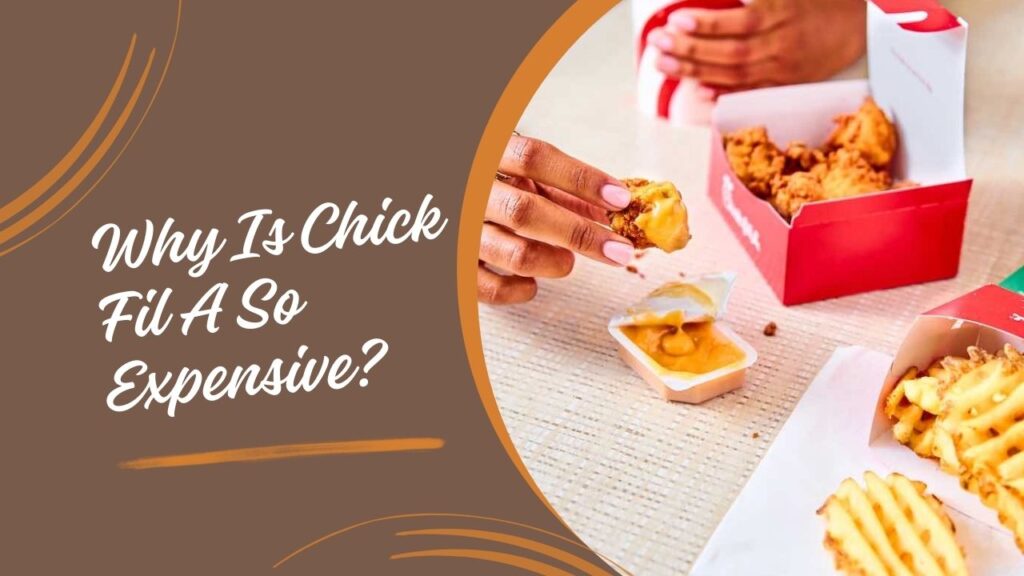Why Is Chick Fil A So Expensive? Chick-fil-A’s higher prices are primarily due to increased costs for ingredients, labor, and transportation.
Chick-fil-A is one of the most beloved fast-food chains in the United States, known for its signature chicken sandwiches, friendly service, and strong customer loyalty.
However, one consistent topic of discussion among customers is the price.
Chick-fil-A’s menu items often come at a premium, leaving many wondering: Why is Chick-fil-A so expensive?
In this blog post, we will explore the factors that contribute to the higher prices and why it’s still worth it for many people.
What Makes Chick-fil-A Different?
Before diving into the reasons behind the higher price point, it’s essential to understand what sets Chick-fil-A apart from other fast-food chains. [Why Is Chick Fil A So Expensive?]
Chick-fil-A’s menu focuses heavily on chicken, and they’re well-known for their commitment to quality ingredients.
The chicken is always fresh, never frozen, and they strive to serve it in a variety of ways, from their signature chicken sandwiches to nuggets and salads.
Beyond the food, Chick-fil-A prides itself on providing a superior customer experience. The service is often praised for its friendliness and efficiency, making it one of the most customer-centric brands in the fast-food industry.
These factors contribute to the perception of value at Chick-fil-A, despite the premium pricing. Chick-fil-A is also known for its corporate culture, emphasizing values such as family, faith, and integrity, which resonates deeply with many customers.
Furthermore, the chain has been a trailblazer in terms of its business model, such as closing on Sundays. [Why Is Chick Fil A So Expensive?]
While this decision reduces the number of potential sales per week, it highlights Chick-fil-A’s commitment to quality of life for its employees and the company’s overall values.
This unique aspect of the brand also adds to its perceived exclusivity and worth, even if it leads to higher prices for customers.
Factors Contributing to the High Price of Chick-fil-A
While Chick-fil-A offers a premium experience, there are several operational costs that contribute to its higher prices.
1. Rising Ingredient Costs
Like many other food businesses, Chick-fil-A is not immune to the rising costs of ingredients. Due to supply chain issues, inflation, and increased demand for high-quality products, the price of chicken and other ingredients has surged.
The COVID-19 pandemic exacerbated these issues, creating labor shortages and difficulties in sourcing key ingredients. As a result, prices for things like chicken, sauces, produce, and even paper products have steadily risen.
Chick-fil-A’s commitment to using fresh, never frozen chicken means they are particularly susceptible to these fluctuations in the market. [Why Is Chick Fil A So Expensive?]
This commitment to quality is important to customers, as the chain’s chicken is known for being consistently tender, juicy, and flavorful. However, it also comes at a price, and that price is reflected in the menu.
Additionally, the company’s focus on quality ingredients extends to other menu items, including fresh produce, specialty sauces, and premium buns.
While this adds to the overall quality of the food, it significantly increases food costs, leading to higher prices for consumers. [Why Is Chick Fil A So Expensive?]
Chick-fil-A’s signature sauces, such as the famous Chick-fil-A sauce and Polynesian sauce, are made from premium ingredients, which, when scaled up, can lead to significant costs.
2. Labor Costs and Employee Benefits
Chick-fil-A also places a significant emphasis on its employees, offering competitive wages and benefits to attract and retain a highly motivated workforce.
This commitment to fair pay is one reason why many customers report positive experiences with the brand’s friendly and efficient service.
Unlike many fast-food chains that rely heavily on minimum wage employees, Chick-fil-A strives to offer a better wage structure and benefits for its staff.
It offers flexible work schedules, scholarships, and opportunities for advancement within the company. [Why Is Chick Fil A So Expensive?]
These employee-friendly policies not only improve the customer experience but also contribute to the overall cost structure.
Moreover, Chick-fil-A’s franchise model often includes certain labor-related policies that provide better benefits to its employees, which ultimately increases operating costs.
This approach is part of the chain’s broader corporate ethos, which includes providing workers with opportunities for career development and fostering a positive work environment.
While this creates a better overall experience for customers, it also impacts menu prices. Higher wages and employee benefits translate into increased labor costs, which inevitably affect the overall price of menu items.
3. Packaging and Sustainability Initiatives
In recent years, Chick-fil-A has made significant strides toward becoming more environmentally responsible. [Why Is Chick Fil A So Expensive?]
The chain has shifted to eco-friendly packaging in many locations, moving away from plastic straws and Styrofoam containers.
While this is a positive step for sustainability, eco-friendly packaging often comes with a higher cost.
Sustainable packaging solutions such as compostable cups, biodegradable straws, and recycled paper products are more expensive to produce and purchase.
However, Chick-fil-A’s commitment to reducing its environmental impact adds an additional layer to the price of food items. [Why Is Chick Fil A So Expensive?]
Customers who are conscious of environmental issues may appreciate this effort, but it also contributes to the overall higher pricing.
This decision to go green has become increasingly important for many brands as consumers express a growing demand for sustainable practices.
As companies aim to reduce their carbon footprint and use fewer single-use plastics, the price of implementing such initiatives tends to be passed on to consumers in the form of higher prices.
4. Transportation and Supply Chain Challenges
The transportation of fresh ingredients and food items is a significant part of any restaurant’s operations.
Over the past few years, fuel prices have risen, and the logistics of getting products to restaurants have become more challenging.
Chick-fil-A is no exception to this, as the cost of transporting its ingredients—especially chicken—has increased significantly. [Why Is Chick Fil A So Expensive?]
The chain has also faced challenges related to the disruption of supply chains, affecting the availability of products and raising the cost of sourcing materials.
As a business with a vast network of locations across the country, Chick-fil-A relies on an intricate supply chain to ensure that each restaurant receives fresh ingredients in a timely manner.
These transportation costs, often exacerbated by rising fuel prices, have forced Chick-fil-A to increase its menu prices to maintain consistent quality and supply.
Additionally, the logistics of delivering fresh, perishable food items is more expensive than transporting non-perishable goods, further contributing to the higher operational costs.
These transportation costs often result in higher prices for customers, as the chain seeks to maintain its product quality and supply chain reliability. [Why Is Chick Fil A So Expensive?]
How Chick-fil-A Maintains Its Premium Pricing
Despite the higher prices, Chick-fil-A has found a way to maintain its strong brand presence and customer loyalty. [Why Is Chick Fil A So Expensive?]
One reason is its reputation for high-quality food and exceptional service. While other fast-food chains may cut corners to save costs, Chick-fil-A focuses on ensuring that every meal is made to the highest standard. This commitment to quality helps justify the premium prices.
Chick-fil-A also benefits from a highly engaged customer base. Many customers are willing to pay a little more for the consistency and reliability that the brand offers.
For instance, the chain’s famous chicken sandwiches are widely considered to be some of the best in the industry, and customers consistently choose Chick-fil-A over competitors for its friendly service and high-quality experience.
Additionally, Chick-fil-A has built a strong brand identity that resonates with consumers. The company’s focus on family values, community involvement, and customer satisfaction has created a loyal following.
This strong emotional connection with the brand allows Chick-fil-A to charge higher prices without losing its customer base. [Why Is Chick Fil A So Expensive?]
Chick-fil-A’s marketing strategy also plays a significant role in its ability to justify premium pricing. Rather than focusing on value deals or price wars, Chick-fil-A positions itself as a premium brand that offers a high-quality experience.
This positioning helps customers perceive the higher prices as an investment in a better overall experience, which, in turn, builds brand loyalty and repeat business.
Is Chick-fil-A Worth the Cost?
With its premium prices, is Chick-fil-A still worth it? For many customers, the answer is yes. Chick-fil-A has created a brand experience that justifies its higher prices.
The quality of the food, the freshness of the ingredients, and the customer service make the extra cost worth it for those who enjoy the brand.
However, it may not be for everyone. For budget-conscious consumers, Chick-fil-A’s prices may feel steep compared to other fast-food options.
But for those who prioritize quality over price and are looking for a more satisfying dining experience, Chick-fil-A remains a top choice. [Why Is Chick Fil A So Expensive?]
One of the reasons Chick-fil-A commands such loyalty is that it consistently delivers on its promise of high-quality food and exceptional service.
Whether you’re craving a classic chicken sandwich, fresh nuggets, or a salad, you can count on the food being well-prepared and delicious.
The customer experience is often cited as one of the best in the fast-food industry, which is not something that can be easily replaced by a cheaper alternative.
Conclusion: Why Is Chick Fil A So Expensive?
Chick-fil-A’s higher prices can be attributed to several factors, including rising ingredient and labor costs, the brand’s commitment to quality and sustainability, and the logistical challenges of running a nationwide operation.
While these factors may make the prices higher than some competitors, they also ensure that Chick-fil-A delivers a premium experience for its customers.
Whether or not the cost is justified depends on your preferences, but for many, the quality and service make it worth the investment. [Why Is Chick Fil A So Expensive?]
See Also: Why Is Tofu More Expensive Than Meat?
FAQs
Why does Chick-fil-A cost more than other fast-food chains?
Chick-fil-A uses high-quality ingredients, pays its employees competitive wages, and invests in eco-friendly packaging, all of which contribute to its higher prices.
Are Chick-fil-A’s menu prices consistent across all locations?
Prices may vary slightly based on location due to regional differences in supply chain and labor costs. [Why Is Chick Fil A So Expensive?]
Does Chick-fil-A offer any discounts or promotions?
Chick-fil-A occasionally offers discounts or promotions, but they are not as frequent as other chains. Some locations may have local specials or rewards for loyal customers.
Why do Chick-fil-A prices keep rising?
The increase in prices is largely due to rising food, labor, transportation costs, and the brand’s commitment to high-quality ingredients and sustainable practices.
How does Chick-fil-A ensure the quality of its food despite high prices?
Chick-fil-A focuses on using fresh, never frozen chicken, and high-quality ingredients, while also providing excellent customer service to ensure a consistent and satisfying dining experience.

Hello, I’m Ashlyn Fleming from Sedona, Arizona. After finishing my Master’s, I noticed rising prices on everything I buy for my family. Curious about why, I started a blog to share my findings with friends and family.
